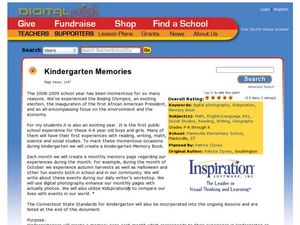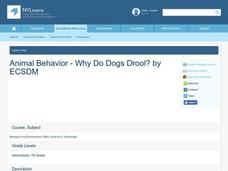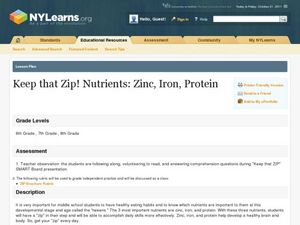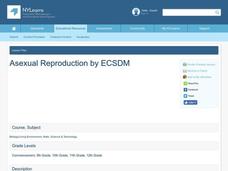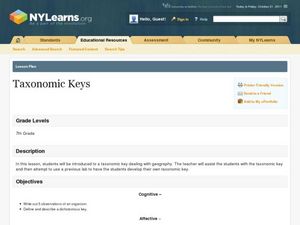Curated OER
The Human Body - Five Types of Human Cells
Learners complete a chart/graphic organizer based on the reading passage and locate specific information within the reading passage to complete the Human Body Cells Chart. They then utilize the Human Body Cells Chart to complete the...
Curated OER
Classification: Dichotomous Key
Students investigate the classification process and nomenclatures used for classifying organisms. They study dichotomous keys to identify organisms with 90% accuracy. Students organize information regarding the relatedness of species.
Curated OER
Identifying Disease Genes using BLAST
Students navigate the National Center for Biological Information (NCBI) website and BLAST program to conduct a variety of biological assignments.
Curated OER
Kindergarten Memories
Students create a monthly memory and compile it into a Kindergarten Memory Book. In this memory book lesson, students create a monthly memory page. Students create a graphic organizer in Kidspiration which is developed into a...
Curated OER
Ordering Geologic Events Using Cross-Sections
Students analyze cross-sections of geologic events. In this geology lesson, students identify the type of environment where the cross-section come from. They take a quiz at the end of the lesson.
Curated OER
How Cells Reproduce
Learners construct a mitosis flip book. In this biology lesson, students describe the different stages of mitosis. They discuss the importance of cell reproduction.
Curated OER
How's the Weather?
Students explore earth science by researching the Internet. In this weather pattern lesson, students utilize the website weather.com to analyze the weather in different geographic locations. Students view charts and graphs based on...
Curated OER
Animal Behavior - Why Do Dogs Drool?
Seventh graders give examples of learned behaviors. In this life science lesson, 7th graders simulate a behavior conditioning experiment. They complete an assessment at the end of the lesson.
Curated OER
Keep that Zip! Nutrients: Zinc, Iron, Protein
Students explain the importance of zinc, iron and protein. For this biology lesson, students create a brochure containing information about the three nutrients. They share their brochure in class.
Curated OER
Bonding Review
Students differentiate metallic, ionic and covalent bonding. In this chemistry lesson plan, students explain how these bonds are formed. They classify substances according their bond type.
Curated OER
Carbohydrates, Proteins, and Fats
Students describe the properties of carbohydrates, proteins and fats. In this health science lesson, students identify food sources where these nutrients can be found. They explain how they affect our body.
Curated OER
The Male Reproductive System
Learners name the different parts of the male reproductive system. In this health science lesson plan, students research health issues affecting the male reproductive system. They create a presentation and share it to class.
Curated OER
Asexual Reproduction
Young scholars identify the different types of asexual reproduction. In this biology lesson, students name organisms that reproduce asexually. They answer an interactive quiz and check their answers afterward.
Curated OER
Probability and Genetics
Learners determine the offspring from a genetic cross. In this biology lesson plan, students use Punnett squares to find probability. They explain how genes are passed from parents to offspring.
Curated OER
How Does Meiosis Lead To a Fetus?
Young scholars discuss the stages of meiosis. In this life science instructional activity, students create an illustration of each stages. They write a short story about a character that went through meiosis.
Curated OER
Vitamin Planet
Students explain the function of vitamins in their body. In this health lesson, students identify the six types of vitamins. They create a chart comparing two of them.
Curated OER
Photosynthesis and Plant Reproduction
Young scholars explain the process of photosynthesis. For this biology lesson, students label the different reproductive parts of the flowers. They watch a short video then identify the leaf parts on the board.
Curated OER
Internal vs. External Fertilization
Students distinguish between internal and external fertilization. In this biology lesson, students classify organisms according to their reproductive method. They simulate the role of parents who reproduce either internally or...
Curated OER
The Skeletal System
Students identify the different parts of the skeletal system. In this biology lesson, students put together a skeleton using an interactive website. They evaluate the accuracy of their own answers.
Curated OER
"Rikki-Tikki-Tavi"
Young scholars explore nature by reading stories in class. In this animal characteristics lesson, students read the story "Rikki-Tikki-Tavi," by Rudyard Kipling and identify the different animals mentioned in the book. Young scholars...
Curated OER
Plant Reproduction
High schoolers identify the different parts and function of a flower's reproductive system. In this biology lesson, students explain how pollination works. They watch a video and practice labeling parts of both flower and leaf.
Curated OER
Puberty
Eighth graders describe the changes their body undergoes during puberty. In this health science lesson, 8th graders explain how the hypothalamus and pituitary gland play a major role in the process. They identify the different parts of...
Curated OER
Classification: Dichotomous Key
Students explain the classification process of organisms. In this biology lesson plan, students practice writing the names of organisms scientifically. They answer the dichotomous key and discuss answers as a class.
Curated OER
Taxonomic Keys
Seventh graders create their own dichotomous key. In this biology lesson, 7th graders classify animals based on their observable features. They explain how to use their dichotomous key.



